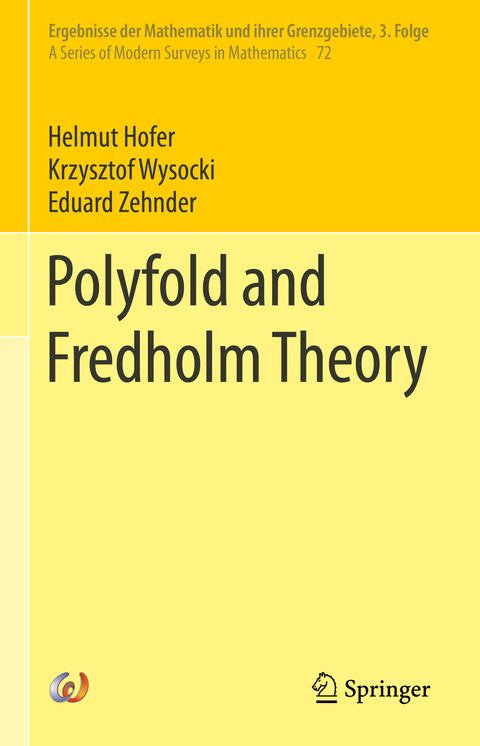
Polyfold and Fredholm Theory
Springer International Publishing (Verlag)
978-3-030-78006-7 (ISBN)
The theory presented in this book was initiated by the authors between 2007-2010, motivated by nonlinear moduli problems in symplectic geometry. Such problems are usually described locally as nonlinear elliptic systems, and they haveto be studied up to a notion of isomorphism. This introduces symmetries, since such a system can be isomorphic to itself in different ways. Bubbling-off phenomena are common and have to be completely understood to produce algebraic invariants. This requires a transversality theory for bubbling-off phenomena in the presence of symmetries. Very often, even in concrete applications, geometric perturbations are not general enough to achieve transversality, and abstract perturbations have to be considered. The theory is already being successfully applied to its intended applications in symplectic geometry, and should find applications to many other areas where partial differential equations, geometry and functional analysis meet.
Written by its originators, Polyfold and Fredholm Theory is an authoritative and comprehensive treatise of polyfold theory. It will prove invaluable for researchers studying nonlinear elliptic problems arising in geometric contexts.
lt;b>Helmut Hofer has contributed to nonlinear analysis, the theory of dynamical systems and symplectic geometry and topology. He is one of the founders of symplectic topology and is known for Hofer Geometry, his work on the Arnold conjectures and Weinstein conjecture, and, with various collaborators and co-authors, symplectic capacity theory, symplectic homology, symplectic field theory, finite energy foliations and their applications to dynamical systems, polyfold theory and feral curve theory. He currently holds the Hermann Weyl Professorship at the Institute for Advanced Study in Princeton.
Kris Wysocki has contributed to nonlinear analysis, the theory of dynamical systems and symplectic geometry and topology. He is known as one of the originators of the theory of finite energy foliations and its applications to Hamiltonian dynamics, the compactness result of symplectic field theory, applications of symplectic homology, and polyfold theory. At the time of his passing he was Professor at Pennsylvania State University.
Eduard Zehnder is one of the founders of the field of symplectic topology. Well known are his contributions to Hamiltonian systems close to integrable ones. Jointly with C. Conley, he proved the Arnold Conjecture for symplectic fixed points on tori. This meanwhile classical result, referred to as the Conley-Zehnder Theorem, together with Gromov's pseudoholomorphic curve theory led Zehnder's student Andreas Floer to introduce the seminal concept of Floer Homology. With H. Hofer and K. Wysocki, he worked on global periodic phenomena in Hamiltonian and Reeb dynamics, compactness problems in symplectic field theory and on the theory and applications of polyfolds. He is currently Professor Emeritus at ETH Zurich.
Part I Basic Theory in M-Polyfolds.- 1 Sc-Calculus.- 2 Retracts.- 3 Basic Sc-Fredholm Theory.- 4 Manifolds and Strong Retracts.- 5 Fredholm Package for M-Polyfolds.- 6 Orientations.- Part II Ep-Groupoids.- 7 Ep-Groupoids.- 8 Bundles and Covering Functors.- 9 Branched Ep+-Subgroupoids.- 10 Equivalences and Localization.- 11 Geometry up to Equivalences.- Part III Fredholm Theory in Ep-Groupoids.- 12 Sc-Fredholm Sections.- 13 Sc+-Multisections.- 14 Extensions of Sc+-Multisections.- 15 Transversality and Invariants.- 16 Polyfolds.- Part IV Fredholm Theory in Groupoidal Categories.- 17 Polyfold Theory for Categories.- 18 Fredholm Theory in Polyfolds.- 19 General Constructions.- A Construction Cheatsheet.- References.- Index.
"The impressive monograph under review develops a general version of differential geometry in which the notion of a smooth manifold is replaced by the much more flexible notion of an M-polyfold, whose initial motivation comes from the symplectic field theory but has many potential applications in other areas of analysis and geometry." (Daniel Beltita, zbMATH 1479.58002, 2022)
“The impressive monograph under review develops a general version of differential geometry in which the notion of a smooth manifold is replaced by the much more flexible notion of an M-polyfold, whose initial motivation comes from the symplectic field theory but has many potential applications in other areas of analysis and geometry.” (Daniel Beltiţă, zbMATH 1479.58002, 2022)
| Erscheinungsdatum | 23.07.2021 |
|---|---|
| Reihe/Serie | Ergebnisse der Mathematik und ihrer Grenzgebiete. 3. Folge / A Series of Modern Surveys in Mathematics |
| Zusatzinfo | XXII, 1001 p. |
| Verlagsort | Cham |
| Sprache | englisch |
| Maße | 155 x 235 mm |
| Gewicht | 1632 g |
| Themenwelt | Mathematik / Informatik ► Mathematik ► Analysis |
| Mathematik / Informatik ► Mathematik ► Geometrie / Topologie | |
| Schlagworte | Bubbling off • Foundations of symplectic field theory • Fredholm Theory • M-polyfolds • Nonlinear Partial Differential Equations • Polyfolds • Scale calculus • Scale smoothness • Symplectic Geometry |
| ISBN-10 | 3-030-78006-6 / 3030780066 |
| ISBN-13 | 978-3-030-78006-7 / 9783030780067 |
| Zustand | Neuware |
| Haben Sie eine Frage zum Produkt? |
aus dem Bereich


